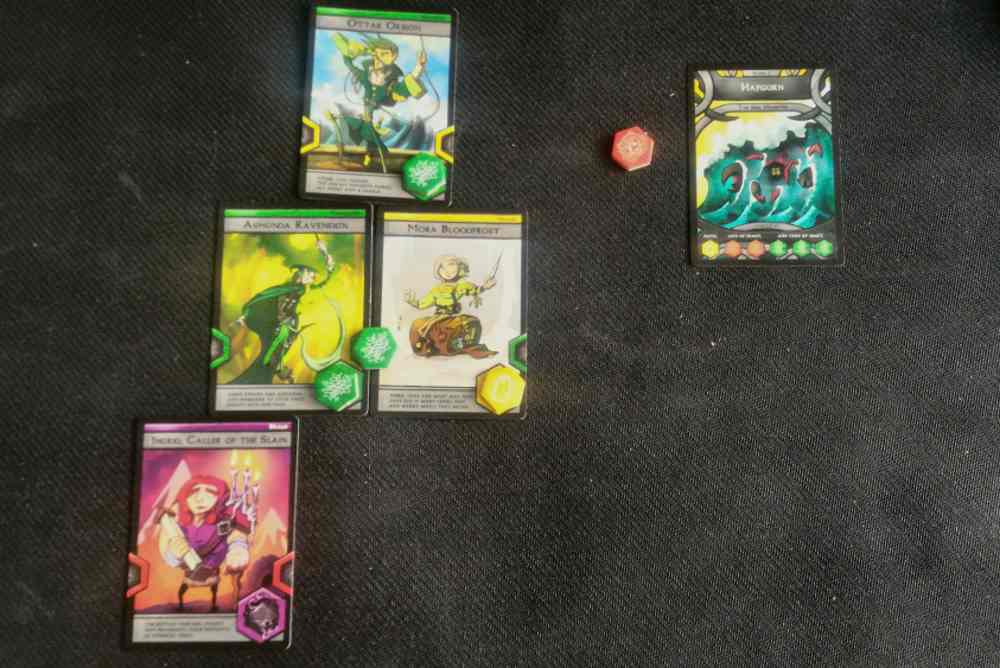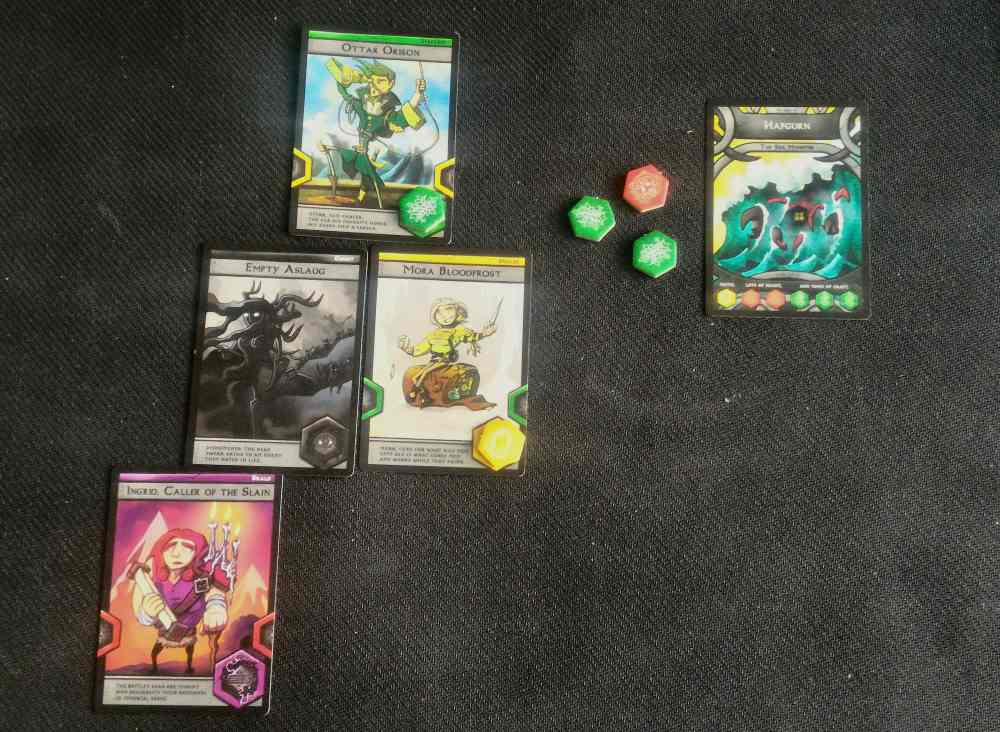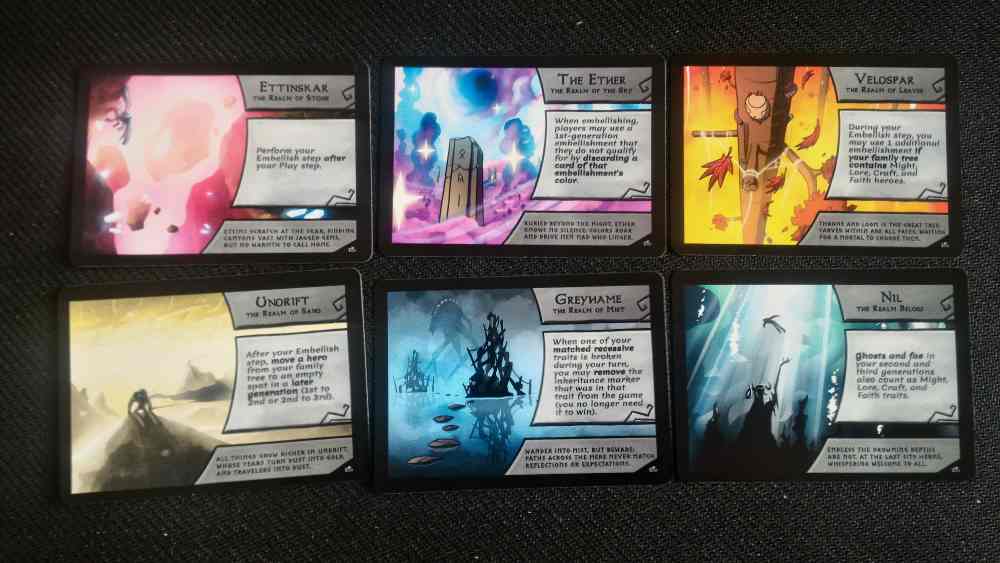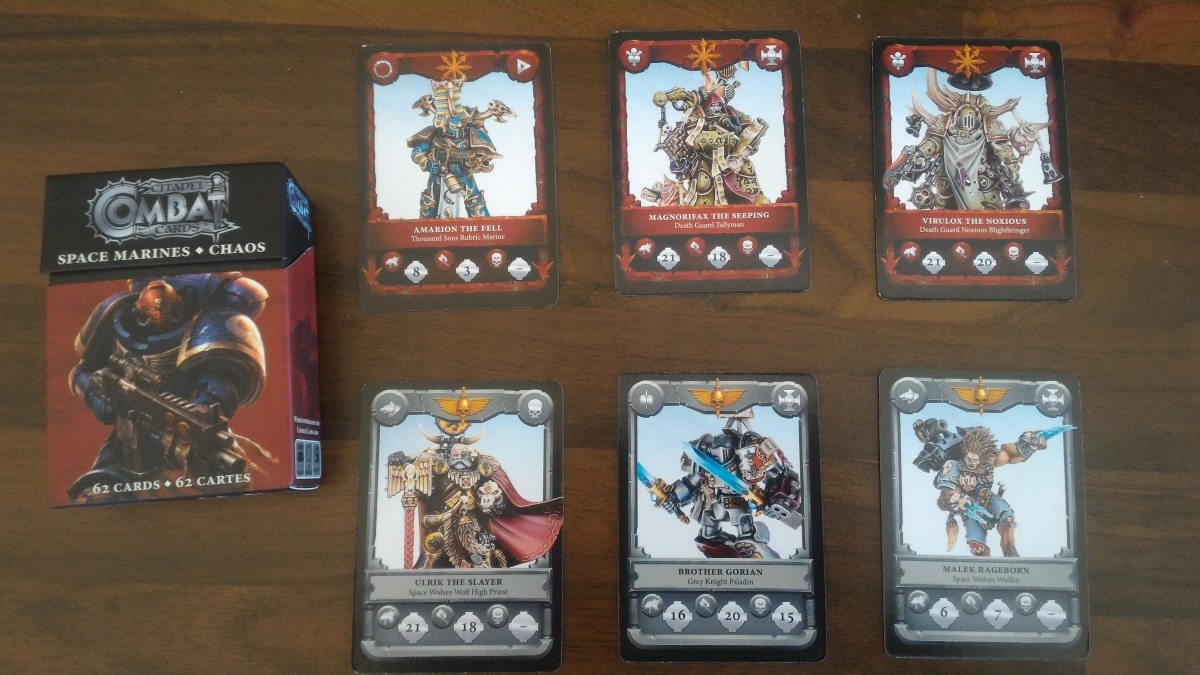
Norsaga is a card game with a storytelling theme. Much like the recently reviewed Shahrazad, it is not a storytelling game, but instead, focuses on the narrator. In the case of Norsaga, each player is trying to build a family tree, making the game an interesting blend of storytelling and genealogy. Recounting sagas is a job best suited to those who have legends as their forebears. The first person to prove (or really, blag) that he is descended from the right stock, is the winner.
The original Norsaga had a successful Kickstarter campaign, followed by an expansion (Into the Myths). Now designers Kevin and Matthew Bishop of Meromorph Games are back looking for funds with a brand new expansion, Odds and Endings.
Missed out on the first game? Not to worry because their newest Kickstarter has a pledge level that allows those new to Norsaga to pick up the existing decks.
New to Kickstarter? Check out our crowdfunding primer, and visit our curated page for more projects we love.
Before detailing the new expansion it makes sense to talk a little about the base game first.
Overview:
Norsaga is a quick to play card game for 2 – 4 players. Players draw from a saga deck to randomly determine which traits their story consists of. They then have to collect the right hero cards to prove their storyteller has the correct lineage to tell the best story. The cartoon style artwork is colorful, fun, and invokes Norse legend; hence the title Norsaga
Components:
68 Hero cards.
40 Saga cards.
48 Inheritance (trait) markers.
4 Doom tokens.
4 Summary cards.
How to Play:
To play the game in its simplest form (recommended for your first few hands,) players start by drawing their Saga card. These have evocative titles such as “The Saga of Skoll the Frost Ettin” or “The Saga of Grimdoll the Unquiet Corpse.”

Each of the saga cards has a set of traits (usually three or four types). Players then have to create a family tree that has these traits represented. Traits are Might (Red), Lore (Blue), Craft (Green), and Faith (Yellow).
To start creating their family trees, each player draws five cards and takes it in turns to lay them down. Players gradually build up a pyramid of cards. 1 card for the youngest hero – in theme terms, the person telling the story, 2 cards for the storyteller’s parents, and 2 sets of 2 cards for the grandparents.

All cards have one dominant trait and one recessive trait. These will both be of one of the four trait colors. The dominant and recessive traits might be the same on a given card, but will more likely be different.
By placing a hero card on the table, players can pick an inheritance trait from that given on their Saga. If two paired heroes share the same recessive trait, players can put an extra trait marker down as these count towards the completion of their story.
The first person to play all the traits from their saga is the winner.

That’s a simple game. They only last about ten minutes and are limited in terms of gameplay. They are, though, the best way to learn about another key component of the game, “Embellishments.” In theme terms, these are twists added to entertain the listener. In game terms they allow you to draw new cards or scupper your opponent.
There are four types of embellishment in the basic game. One for each trait type. Usually, players can only play one type of embellishment in a turn. This is of the color given by the youngest hero in the family tree. If your top hero has a blue trait, you can perform blue embellishments.
There are three levels of embellishment. One for each generation. If your first and second generation of heroes both contain blue cards you can perform level 1 or level 2 embellishments. The embellishments are themed to the trait in question. So red (Might) embellishments tend to be more violent than, say, blue (Lore). Embellishments are a good way to play extra cards, which, as you are trying to lay your heroes down as fast as possible, is very useful.
Turn Order:
Turn order is always the same.
- Take a breath – restock your hand to five cards.
- Perform embellishment. If you can, this is when you perform your embellishment.
- Play a hero. You play a hero onto your tree. These can be placed in any order. Normally it’s good to work from the apex of the tree backwards because it gives you stronger embellishments, but if you particularly want to play a grandparent card when there are no parent cards, you can. Cards can also be placed on top of existing heroes. In which case, the original hero is dismissed to the discard pile. If the new card has a different trait to that of the dismissed card, then that trait is returned to the saga card, and will have to be placed again.
A simple game even with embellishments won’t occupy for long. Things largely come down to luck. Including the full rules introduces elements of skill.

There are two color cards not used in the basic game. Black and Purple.
Purple cards, or Skalds, only contribute a recessive trait. Playing them does not allow you to play a trait token from your Saga card. You can however immediately gain an extra embellishment, so there are times when purple cards are useful.
Black Ghost cards allow you to mess with your opponents stories. They can be played directly onto an opposing player’s family tree, dismissing the card they are placed on. This can be used to send traits skittering back to your opponent’s saga card and undo all their careful genealogical planning.
Black cards have an extra sting in their ethereal tail. They have their own Embellishments. These can be pretty nasty, especially to those who were unkind enough to lumber you with the ghost in the first place, but there is a drawback. If you invoke a black embellishment you are “Doomed” for the subsequent turn and all players can play cards on your family tree if they wish. This means your opponents pretty much have open house on all your plans, so think carefully before invoking ghosts to your aid.

And that’s about it. The base game is fun to play and portable. 2 player games are very quick, around 15 mins, though as a result feel more limited than games with three or four players. In a two player game, if the cards fall right, it’s possible to fulfil all your trait requirements before there’s chance for much skulduggery. Games with more players offer more tactical choices and running interference on your opponent’s plans pays greater dividends.
The Odds and Ends expansion.
The Odds and Ends deck offers some new cards and some alternatives to playing the straight game. A deck of Odds and Ends, if you have the base game, will cost $8, with minimal shipping costs. The campaign has a modest funding target too.
Expansion Contents:
- Rules
- 8 Reference Cards
- 16 Immortal Cards
- 12 Heirloom Cards
- 8 Relam Cards
- 4 Skald Hero Cards
The reference cards offer slightly different embellishments from the base game. They are essentially the same, but streamlined a little for a more refined gameplay experience.
Immortals.
A new type of hero to aid your storytelling endeavors. Two new types in fact. But first Immortals have to be called to your side. Immortal cards are chosen randomly and are double sided. One side (the one that starts facing upwards,) contains the two traits you need to have in your family tree to unlock them. These traits have to be unlocked in order. So, if you have an immortal that is green then red. Only placing a green hero will unlock the first trait. You can then unlock the second with a red hero. Note: If you alreaddy had a red hero in your tree, placing the green hero would unlock both traits and free your immortal.

At which point you turn over the Immortals card. Guardian Immortals are essentially moveable heros. You can place them over any hero in your tree, but that hero is not dismissed like in the normal game. You can move the Immortal at any time and the old hero will still be in place (If that space is dimissed by use of a ghost card, the immortal returns to the player and the hero card beneath is dismissed to the discard pile.)
Watchers are the second type of immortal. They have a color and that color can be used to enact a first level embellishment at the start of a given turn. This is a free embellishment in addition to the one your heroes in your tree will give you. After that, the Watcher is exhausted and must be reset in the following turn. This means you can only use the extra embellishment on alternate turns. It is still a powerful card, and in my (limited) experience, it’s better to have a Watcher than a Guardian.
Heirloom Cards.
These too are double-sided. They start on the cursed side facing upwards. Each cursed heirloom has three traits associated with it, again with an order. Each time you dismiss a hero that is of the corresponding color of the next trait in your heirloom’s sequence, you are one step closer to removing the curse.

Once the curse is removed you turn the heirloom over and you can start using it. Each heirloom has a color and this color is useable by your youngest hero, as well as its own, when working out what possible embellishments you can use.
Realm Cards.
One of these is picked randomly each game. They provide fun global effects that alter the entirety of that game, for all players
The Verdict: Do I need this expansion?
Well, the short answer is “No,” but, “Do you want it?” At that price, why would you not? Norsaga is a better 4 player game than 2 player and that’s true with the expansion deck too. There’s more time to fully explore the potential of the new cards. You don’t have to use all the expansions at once, and I would recommend not doing so, at least at first, and probably for always, for two-player games. 2 player games are too quick to allow all the new cards to be properly utilized.
Heirloom cards are trickier than the Immortals to unlock, and I think benefit from being the only additional cards used with the base game. The Realm cards add a global change which subtly alters the playing field for all players in the same way. They’re great for experienced players of the game. My only issue with the expansion is that the double-sided cards are difficult to pick at random, as you can always see one side when shuffling.
Norsaga is a fun little game and this expansion adds extra flavor, especially for long-term players. Players new to the game can pick up all three versions of the game (base set and the two expansions (including Odd and Endings), in the current Kickstarter.
I really like Norsaga. It’s easy to teach and quick to play. There is rather more luck involved than in some games I’m used to playing, especially in the two player game, and this won’t suit all tastes. It is a kid-friendly game as the tactics aren’t too heavy. The artwork and theme will appeal to the legend seekers amongst you. If you like the sound of the game from this review, check out the Kickstarter now.

Disclaimer: GeekDad received a prototype of Odds and Endings to play and a complete set of the base game.




In several of the photos in this review, you show an inheritance marker on both of a pair’s (parents or grandparets) dominant traits. This isn’t actually allowed – from the rule book:
“You can only inherit one dominant trait from a single pair of heroes.” and “Remember, paired heroes cannot both contribute their dominant traits to your saga.”
You also don’t necessarily play “trait tokens” (the rulebook calls them inheritance markers) when you play a hero. From the rulebook:
“TIP You can rearrange your inheritance markers whenever you want; they’re just a way to track how close each player is to winning. Update them whenever your family tree changes.”
Try playing this again without claiming every dominant trait – only one per pair – and I hope you’ll find that it takes a bit longer, even in a two player game, and allows for a little more skullduggery.
Cheers,
Evn
Thanks Evn, you’re right, I completely missed that rule. Thanks for pointing that out. We’ve enjoyed the game anyway, but we’ll have to try it out.
I keep meaning to write a post about the perils of missing a rule and playing incorrectly for long periods of time. Often the game doesn’t noticeably break and it can be hard to spot false assumptions that were made when learning the game.